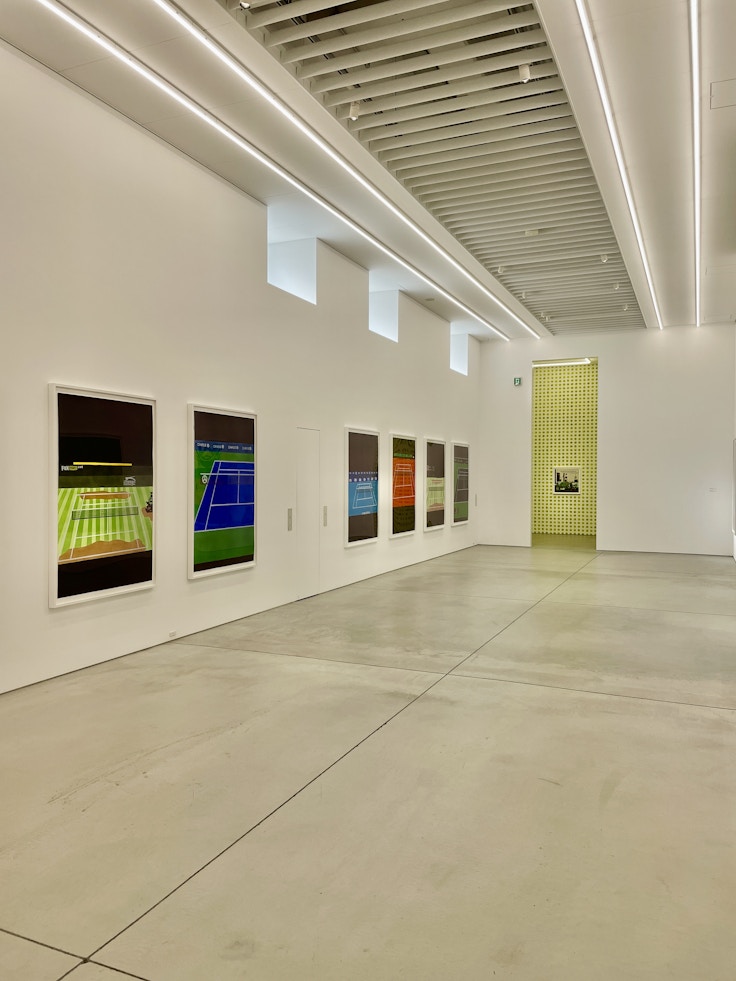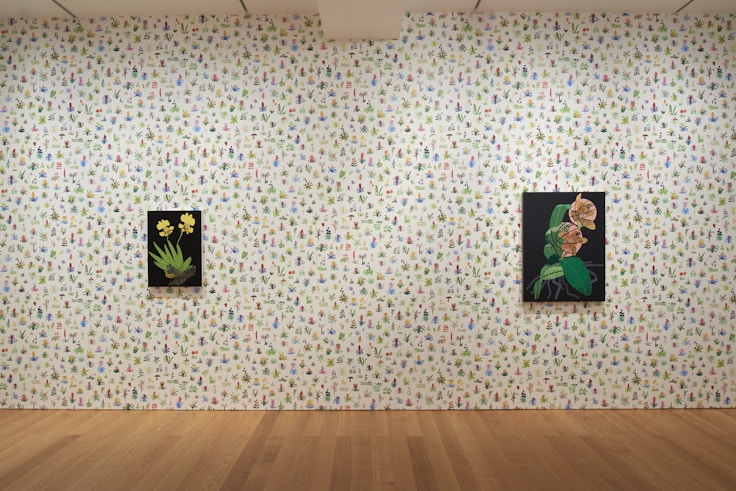Bijutsutecho (BT): Your grandfather was a painter whose art collection included works by artists such as Alexander Calder, Francis Bacon, Robert Motherwell, and Helen Frankenthaler. How did growing up surrounded by these works influence your art and career?
Jonas Wood (JW): I didn't realize the caliber of the art I was living with growing up until I went to graduate school and studied art history for the first time.
I knew Francis Bacon was important and I could definitely feel the energy from that painting, and looking back at photos, it's incredible to see my family standing in front of it.
So, when I was in graduate school, it struck me that I had been around great art that had probably spoken to me in some way. I have to thank my family for surrounding me with art growing up.
BT: You studied psychology for most of your time at Hobart and William Smith College, before taking up painting in your final year. Can you tell us about the reasons for this transition?
JW: I finished the requirements for my major in three years at a four-year college. I majored in psychology, and I was studying child development and dyslexia. I finished after three years, and then I went abroad to Europe.
I had been making art my whole life and I wanted to study it more. I was in Europe writing a paper about dyslexia, but I also got to study art. I saw a lot of it during my time there and I decided I wanted to learn how to paint.

I contacted one of the professors who I had taken a painting class with a year before and asked him if I could create an independent course and learn how to paint. That’s when I really started thinking about painting – in 1999.
A year later, I went to graduate school, using the paintings I made to apply. And I began my painting practice.
BT: After graduating from the University of Washington in 2002, why did you choose to move to Los Angeles rather than New York or other cities?
JW: I chose Los Angeles because Matt Johnson told me that I should come to Los Angeles.
I'd never lived in New York and I’d never lived in Los Angeles. I'm from Massachusetts, which is the East Coast, but definitely not in New York.
I had gone to school in Seattle on the West Coast and I really liked the pace of life there, which was a little bit slower compared to the East Coast.
Matt Johnson was the only friend I knew when I moved here, and that's probably why I moved here – because he told me it was going to be great.

BT: When you first moved to Los Angeles, you worked as an assistant in the studios of artists Laura Owens and Matt Johnson. How did this experience influence your later works?
JW: I worked for Matt Johnson, Laura Owens, and also Mindy Shapero.
I worked for Matt first. He was and still is so organized and had people helping him with his work. Then I worked for Laura for almost two years. I was heavily influenced by her in a variety of ways, from how she ran her studio to the way that she thought about approaching making art and how she approaches living as an artist.
They're both major influences in how I put together my studio practice, how I wanted to work and how I wanted to try to make my best art. From working for both of them and being around them, I could see that they set themselves up to be so successful in their practice. I want it to be successful in my practice, so I really try to incorporate the things I’ve learned and use them for myself.
BT: Which artists have had an influence on you? Some critics have compared your art with works by Henri Matisse and David Hockney.
JW: Well, I feel like I'm influenced now more by contemporary art. I see a lot of contemporary art. When I was younger and studying, it was a lot of older work, and now I guess it's kind of a combination of both of those things.
For sure, Picasso. Thinking about Van Gogh, Monet, Matisse, Hockney - it is the idea of the artist’s line. What is Egon Schiele’s line, or what is Giacometti’s line or what is Henry Moore's line?
So, I was influenced by trying to find my own line, my own voice. To draw or paint something from your everyday life, but in your own way. I’m very influenced by Matisse and Hockney, of course.

BT: You mentioned in another interview that you "work from photos" and you " either make a collage of those things or work directly from photos". Can you tell us more about your working process from studies to finished work?
JW: I collect a lot of photos and I think about different kinds of paintings that I want to make. Sometimes it's just from one photo and other times it's from a bunch of photos that I combine together.
For example, I take an apple from this photograph, and I use a parrot from this photo that I took when I was a kid, and I use this landscape that I found in a National Geographic Magazine, and I put them all together. Sometimes people send me photos and I use them, though very rarely.
A lot of times I take pictures or I see pictures on the internet, screenshot them, print them out and then pin them up in my studio. I sort of have an archive of pinned up photos. And I have a huge archive of photos that I haven't printed out that are in my phone, since I've been taking pictures on my phone for at least the last eight or nine years. I haven't taken any photos with a digital camera.
A good amount of the time I make a drawing. I make a drawing either from a direct picture or I put a bunch of different things in a drawing and figure out a new kind of way of seeing this thing. Sometimes I use those drawings as a model to make a painting and sometimes I have no model except for photos and tracings. So it's kind of a combination of things. I paint from general to specific in acrylics and oils.

BT: Your work often focuses on interior spaces and the interiors within them, why are you interested in such themes?
JW: I like painting interiors. I'm interested in focusing on them because they're challenging for me to paint. The interiors are places I’ve been to, places I want to be, or places I've made up.
I also paint in genres or type. I have a typography of painting and I love to paint interiors. I also love to paint portraits, still lifes, and objects. I like to doodle.
So it's a type of painting I like to come back to. The interiors are usually larger and quite complicated. I did a variety of interiors in which the space was inside and outside at the same time with windows. It’s an endless treasure trove of painting ideas.
BT: You mentioned in another interview that in recent years your work has gone “from still life to taking pots out of the painting, then taking giant plants out of the painting”, which seems to reflect the change in your style in recent years. Looking back on your 20+ years of career, how have your themes and styles changed and how do you see these changes?
JW: Well sometimes I think that I haven’t changed at all, that I'm the most repetitive artist. But I like to think that I'm trying to get better at my practice.

I think styles have changed and the way I approach painting has changed, but I always seem to go back to very similar groups of painting ideas, portraits, still lifes and landscapes and interiors. I guess the themes have changed. I'm interested in painting a lot more object paintings - painting one object as opposed to a set place.
I guess I started to take more things out of the painting. I think I've been doing that more than people realize, but I've been taking plants out of still life paintings and making them bigger. Making plants bigger and then thinking – that's going to look much better smaller and in a still life and passing things around through bodies of work.
BT: "Tennis Courts" is one of your best-known series. The collection exhibition at Maki Gallery in Tokyo has a "Jonas Room" with impressive works from the series as well as wallpapers with elements of tennis and basketball. Can you tell us about the background of creating this series?

JW: Maki owns these 24 tennis court drawings that I made for Shane Campbell Gallery in Chicago in 2018.
It was a group of 24 drawings that I wanted to show all together, and Maki, with his great generosity, purchased them as a promised gift to LACMA, which is one of the best museums in the world.
So, he's been showing them in Tokyo, and he’s also installed my wallpaper which is really cool.
The tennis court series started as me taking pictures of the TV in my studio. I was painting in kind of vertical format, and I started to make drawings and paintings around them. I had been making them for five or six years before I had the show in Chicago where I put a big collection of drawings together.

BT: Basketball is also a recurring element in your paintings, why are you interested in sports elements?
JW: I love sports, so I'm just painting the things I love in my life.
BT: On November 23rd, Gagosian Hong Kong will host your new solo exhibition. Can you tell us about the works shown in the exhibition?
JW: I made new paintings of plants and still lifes on black backgrounds that I'm showing on top of a new floral wallpaper that I made. I’m also showing a couple of groups of drawings that I made.
BT: What kind of themes do you want to try in the future and what are your future plans?
JW: I have a show with David Kordansky Gallery opening January 22, 2022. There are going to be a lot of plants and animals in that show.

- 1
- 2



















